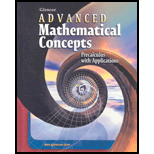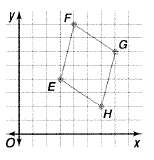
whether
Answer to Problem 11CFU
Parallelogram
Explanation of Solution
Given information:
If both pairs of its opposite side are parallel, then the quadrilateral is a parallelogram.
A parallelogram is a rectangle if its adjacent sides are perpendicular.
The given quadrilateral is shown below.

From the graph,
Calculation:
The formula of slope is as follows:
Substitute the required values in the slope formula to evaluate the slope for
Substitute the required values in the slope formula to evaluate the slope for
Substitute the required values in the slope formula to evaluate the slope for
Since, the slope of
Substitute the required values in the slope formula to evaluate the slope for
Substitute the required values in the slope formula to evaluate the slope for
Since, the slope of
Since, both pairs of the opposite sides are parallel. Thus,
Since, the slope of
Thus, the
Chapter 1 Solutions
Advanced Mathematical Concepts: Precalculus with Applications, Student Edition
Additional Math Textbook Solutions
Algebra and Trigonometry (6th Edition)
Pre-Algebra Student Edition
A Problem Solving Approach To Mathematics For Elementary School Teachers (13th Edition)
Intro Stats, Books a la Carte Edition (5th Edition)
Thinking Mathematically (6th Edition)
- Sketch a graph of f(x) = 2(x − 2)² − 3 4 3 2 1 5 ས་ -5 -4 -3 -2 -1 1 2 3 4 -1 -2 -3 -4 -5+ Clear All Draw:arrow_forward5. Find the arc length of the curve y = 3x³/2 from x = 0 to x = 4.arrow_forward-6 -5 * 10 8 6 4 2 -2 -1 -2 1 2 3 4 5 6 -6 -8 -10- The function graphed above is: Concave up on the interval(s) Concave down on the interval(s) There is an inflection point at:arrow_forward
- 6 5 4 3 2 1 -6 -5 -3 -2 3 -1 -2 -3 -4 -5 The graph above is a transformation of the function x² Write an equation for the function graphed above g(x) =arrow_forward6 5 4 3 2 1 -1 -1 -2 -3 -4 A -5 -6- The graph above shows the function f(x). The graph below shows g(x). 6 5 4 3 2 1 3 -1 -2 -3 -4 -5 -6 | g(x) is a transformation of f(x) where g(x) = Af(Bx) where: A = B =arrow_forward5+ 4 3 2 1. -B -2 -1 1 4 5 -1 -2 -3 -4 -5 Complete an equation for the function graphed above y =arrow_forward
- 60 फं + 2 T 2 -2 -3 2 4 5 6 The graph above shows the function f(x). The graph below shows g(x). फ 3 -1 -2 2 g(x) is a transformation of f(x) where g(x) = Af(Bx) where: A = B =arrow_forwardLet f(x) = 4√√ If g(x) is the graph of f(x) shifted up 6 units and right 3 units, write a formula for g(x) g(x)=arrow_forwardSketch a graph of f(x) = −2|x − 3| +2 5 4 3 2 1 -5 -4 -3-2 -1 -1 -2 -3 -4 -5+ Clear All Draw: -2 3 4arrow_forward
 Calculus: Early TranscendentalsCalculusISBN:9781285741550Author:James StewartPublisher:Cengage Learning
Calculus: Early TranscendentalsCalculusISBN:9781285741550Author:James StewartPublisher:Cengage Learning Thomas' Calculus (14th Edition)CalculusISBN:9780134438986Author:Joel R. Hass, Christopher E. Heil, Maurice D. WeirPublisher:PEARSON
Thomas' Calculus (14th Edition)CalculusISBN:9780134438986Author:Joel R. Hass, Christopher E. Heil, Maurice D. WeirPublisher:PEARSON Calculus: Early Transcendentals (3rd Edition)CalculusISBN:9780134763644Author:William L. Briggs, Lyle Cochran, Bernard Gillett, Eric SchulzPublisher:PEARSON
Calculus: Early Transcendentals (3rd Edition)CalculusISBN:9780134763644Author:William L. Briggs, Lyle Cochran, Bernard Gillett, Eric SchulzPublisher:PEARSON Calculus: Early TranscendentalsCalculusISBN:9781319050740Author:Jon Rogawski, Colin Adams, Robert FranzosaPublisher:W. H. Freeman
Calculus: Early TranscendentalsCalculusISBN:9781319050740Author:Jon Rogawski, Colin Adams, Robert FranzosaPublisher:W. H. Freeman
 Calculus: Early Transcendental FunctionsCalculusISBN:9781337552516Author:Ron Larson, Bruce H. EdwardsPublisher:Cengage Learning
Calculus: Early Transcendental FunctionsCalculusISBN:9781337552516Author:Ron Larson, Bruce H. EdwardsPublisher:Cengage Learning





